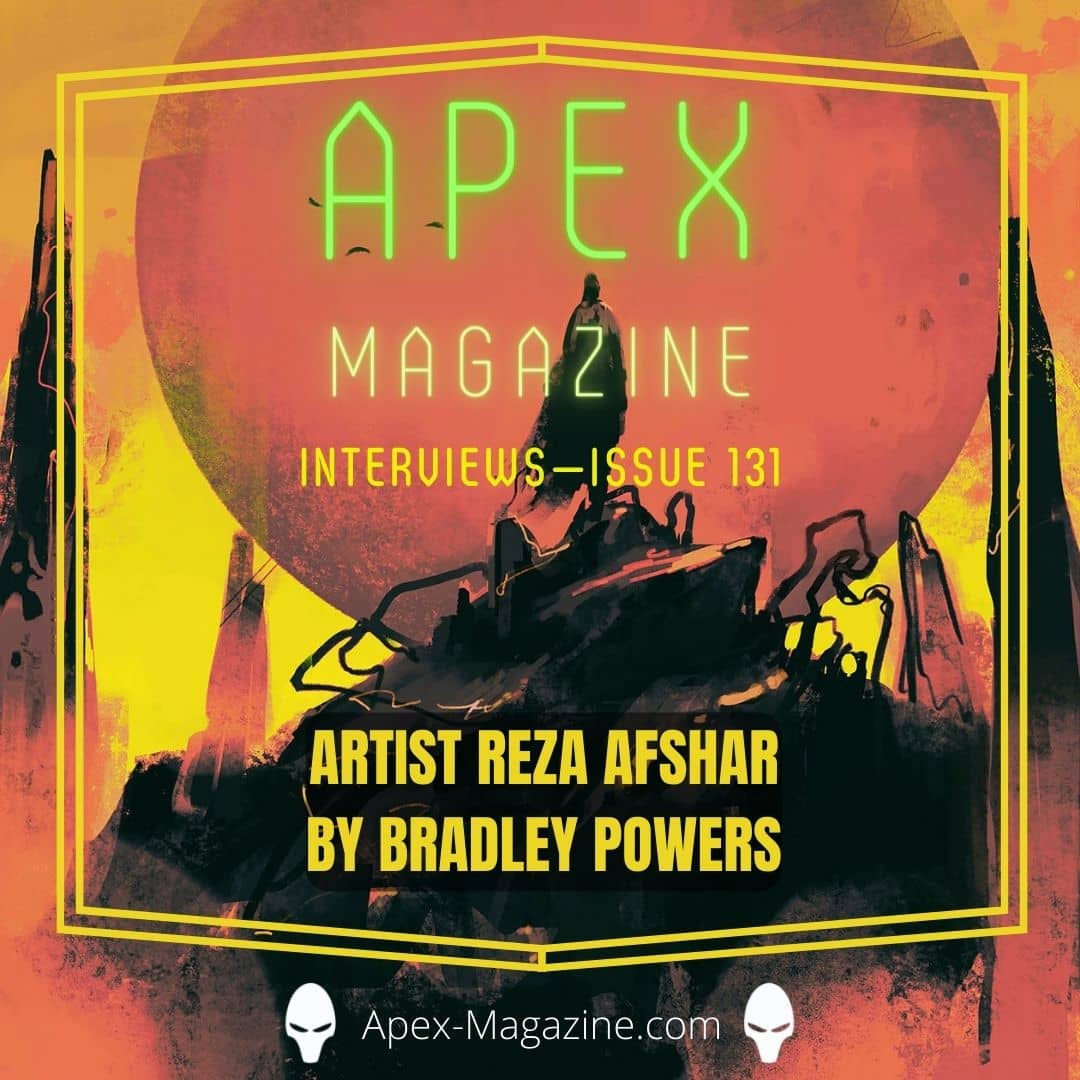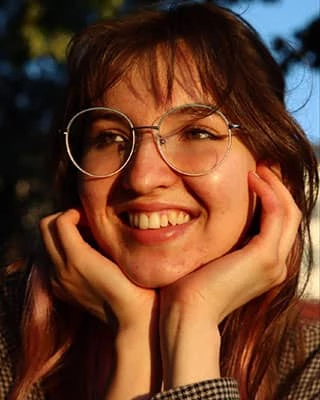
This month’s cover art comes from Reza Afshar, a freelance environment-concept artist and illustrator. His work features fantastical landscapes that invite the illustrated characters as well as the viewers to explore and bask in the beautiful settings.
§
APEX MAGAZINE: From the characters to the intricate buildings to the intriguing use of color, can you describe your process? What is the difference in the process between making a piece for yourself and making a piece for a client?
REZA AFSHAR: When working on personal illustrations, I usually start working in grayscales. Sometimes I start with a sketch, but mostly I paint with big brush strokes and shapes that I amend and twist while the picture starts to come to life on the canvas. I guess the artwork draws itself in my mind at the same time it is built on the screen; it is inherently linked. I don’t really have to think about it that much before starting. It’s a bit like modeling with clay—adding or taking details off. For me, painting is never a strict and straight path, but more of an exploration through matter, colors, and lights.
The main difference when I work for a commission or a client is that I have a brief that needs to be followed. In order to achieve that, I tend to search for references: classical paintings I love, interesting objects, movie scenes, etc. Then, when I have looked at enough of them, I start my process, from scratch most of the time, and build the illustration as I would with my own paintings using big strokes. I think I tend to go directly to colors when it’s for a commission because I already have some references and guidance on the required atmosphere. When it comes to my own artworks, I want to be as free as possible to let the feelings arise; thus, I feel more comfortable using grays and going to colors afterward, according to what the illustration becomes.
AM: Using digital painting, there are many texture brushes available, and one can even create their own to achieve a variety of different styles in a single medium. This is evident in your works such as “Archedium,” which is reminiscent of printmaking, and “3/11/19,” which looks like an ink drawing. Why is digital art your medium of choice, and what inspires you to explore such vastly different styles within the medium?
RA: Ha-ha, I don’t know. I think digital art is really comfortable and easy to work with—all you need is your iPad or graphic pen and tablet. And yes, there are so many brushes you can try or create. I have bought some and created some too, but I mostly work with the same batch of brushes. I sometimes get tired of doing the same kind of things and have the desire to change. Then I can try working with only the mouse using simple geometric shapes, for example. I do inking drawings too—I love to do so—and can use those sketches to be the start for digital illustrations. Also, it is not that easy to come across good art supplies in Iran, so digital tools are pretty handy.
As for changing from one style to another, all I can say is I draw a lot. And I sometimes feel like I’m doing the same thing every day. So, I need to try different styles and move forward. There are so many pictures to look at and discover every day in paintings, anime, video games, etc. And loads of artists, comic books illustrators, classical painters, or trendy concept artists. They inspire me a lot, so I try to improve and learn from all that stimulates me.
AM: Most of your characters' faces are not visible, yet they portray emotions so effectively. How do you achieve this?
RA: Again, I don’t really know. Because the characters I draw are usually so small compared to their surroundings, they are almost one with the landscapes. I very often depict them as peaceful, never running or tense, because that is the way I look upon life. They are often alone too, and all things considered, they become very important. If I were to put many characters in the same painting, they would have to be doing things, interacting. That would probably tell more, become a narrative illustration, but the feelings would be less intense. It is what happens when I draw an army or a scene for commission work. It tells more about the action but conveys less feeling.
I don’t think you need to see one’s face to understand a feeling. Of course, facial expressions and features can help, and I sometimes paint portraits to try and show some specific feelings, but the posture and figure of a being in his or her surroundings is more important to me. Everyone is related to their environment; it defines us, it rebounds on us, and can tell a lot.
AM: There’s a unique use of scale in your work. The huge vast buildings and small characters invoke a feeling of being small and in awe of the landscape in front of us. Is there a reason that this scale is so common in your work?
RA: To be honest, I don’t really think that thoroughly when creating. I don’t intend to make landscapes that big or to make the characters so small. It is just natural to me. I guess it comes from me living in Iran. I am surrounded by very vast and huge landscapes, mountains, and rocks. When I go and take a walk in the mountains, I can look at the horizon and see big yellow stone shapes silhouetted against the immensity of the sky. I can stay there and not meet anyone for hours. I like this feeling of seclusion and peace. I guess that’s what I feel when I look at my surroundings, and it comes to me naturally when I paint. There is no sadness in this, and I guess people don’t consider my illustrations to be sad or crushing ones. It is just what being human is to me: tiny wanderers facing the force of nature.
AM: All of your works seem to be a glance into an epic journey. Do you have a distinct idea of this journey in mind when you create a piece?
RA: Well, it is once again a matter of feelings. I just love the idea of exploring, walking through life, through landscapes, discovering. Just as every stone or crack in a rock can be seen as a magical key for your imagination, I think illustrations are there to make us wonder and dream. Most of those I paint are my dreams, my way of seeing the world or imagining other realities. They are not very defined in my head; they just happen to come across my mind and materialize on my canvas.
AM: Thank you so much, Reza, for such a beautiful cover and thoughtful interview! You can find more of Reza’s work at www.deviantart.com/artofreza/gallery and on Instagram @rezaa_afsharr.









